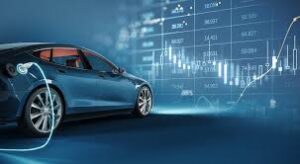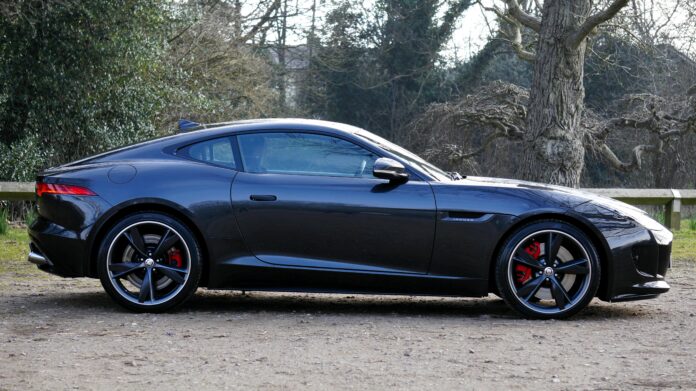Introduction to the Controversy:
Jaguar, the renowned British luxury car manufacturer, has recently unveiled a bold new rebrand, featuring a fresh logo and a promotional video that has sparked significant criticism online. The rebrand, which aims to signal a shift towards an all-electric future, is set to be officially launched on December 2, 2024, during Miami Art Week. The event will coincide with the unveiling of Jaguar’s highly anticipated new electric Grand Touring (GT) model. However, the promotional campaign for the rebrand, particularly the video and the design choices, has generated a wave of negative reactions from fans, car enthusiasts, and critics alike.

The Promotional Video: A Departure from Tradition
The promotional video that was shared on social media platforms such as X (formerly Twitter) and Instagram showcases models dressed in brightly colored, futuristic outfits, walking through a surreal, alien-like landscape. The video is accompanied by the slogan “Copy Nothing,” with the message urging viewers to embrace boldness and reject the ordinary. The imagery in the video is abstract, with no direct connection to the car models that Jaguar is known for. Instead of showcasing the sleek, high-performance vehicles Jaguar is famous for, the video focuses on eccentric fashion and an avant-garde aesthetic.
This approach has left many confused, as they expected to see a clear connection between the rebrand and Jaguar’s iconic sports cars. Many viewers expressed disappointment that the video lacked a prominent focus on the actual cars themselves. The absence of the vehicles left a void in the brand’s messaging, leading to widespread questioning about the company’s direction and the true purpose of the campaign.
Elon Musk’s Reaction: A Question About Jaguar’s Purpose
Among the many reactions to the rebranding campaign was a tweet from Elon Musk, owner of X, who bluntly asked, “Do you sell cars?” This comment reflects the skepticism that many social media users shared regarding the rebrand’s approach. Rather than showcasing Jaguar’s high-performance cars, the promotional video seemed to stray from the brand’s established identity. Musk’s remark highlights how the lack of any clear focus on Jaguar’s core products (luxury cars) caused confusion about the brand’s purpose moving forward.

New Logo: A Stylized “Leaper” Image
Another element of the rebranding that has attracted criticism is the updated Jaguar logo. The iconic “leaper” image, which has long been associated with the brand, has been reimagined in a more stylized and abstract form. Some Jaguar enthusiasts have voiced their displeasure with the new logo, arguing that it strips away the visual identity of the brand that has been cherished by generations of car fans. Critics believe that the redesigned logo fails to capture the elegance and power that the original design conveyed.
Industry Expert Analysis: A Misstep in Marketing?
Charles Taylor, a marketing professor at Villanova School of Business in Pennsylvania, expressed his concerns about the direction Jaguar is taking with its rebrand. According to Taylor, the promotional video and new logo strike a tone that is disconnected from what potential buyers expect from a luxury sports car brand. He emphasized that the company could have built upon its existing reputation as an elegant British manufacturer of high-performance cars, particularly with the introduction of an electric vehicle. Instead, Jaguar’s rebrand seems to abandon its heritage in favor of a bold, yet possibly alienating, new identity.
“If they came back with a really good electric vehicle, they could build on their prior image as opposed to really throwing out the heritage of the brand and going in this kind of direction,” Taylor stated. He further expressed doubt about whether the market for this new approach is large enough for Jaguar to thrive, suggesting that the company risks losing touch with the core audience that has supported the brand over the years.
The Power of Rebranding in the Business World
Rebranding is a strategy often used by companies seeking to revitalize their image, attract new customers, or signal a shift in their business focus. Jaguar’s rebrand is part of a broader industry trend in which traditional automakers are increasingly moving toward electric vehicles. This transformation is driven by the growing demand for sustainability, as well as pressure from regulatory bodies to reduce emissions.
However, as history has shown, rebranding can be a double-edged sword. While some rebrands have been successful in reinvigorating a company, others have faced backlash for alienating loyal customers. One well-known example is Tropicana’s 2009 rebrand, when the company changed its logo and packaging, only to face public outcry for removing its iconic orange. The backlash led Tropicana to revert to its previous design. Similarly, in 2008, Radio Shack rebranded as “The Shack” but faced criticism for distancing itself from its established brand identity, contributing to its eventual bankruptcy in 2015.
Jaguar, too, faces the risk of misfiring with its rebranding efforts. The company must strike a delicate balance between appealing to younger, tech-savvy consumers who are interested in electric vehicles, while still honoring the legacy of its luxury sports car heritage.
The Electric Future: Jaguar’s Vision
Despite the criticism, Jaguar’s move toward an all-electric future is in line with the broader automotive industry’s shift towards sustainability. The electric vehicle market is growing rapidly, and Jaguar Land Rover, as part of India’s Tata Motors Ltd., is positioning itself to be a major player in this transition. The company’s decision to unveil a new electric GT model at Miami Art Week suggests that it is serious about its commitment to electrification.
The upcoming electric vehicle will likely be a key part of Jaguar’s strategy to redefine itself for the 21st century. By positioning itself as a leader in electric luxury vehicles, Jaguar hopes to attract a new generation of customers who prioritize environmental consciousness without compromising on style, performance, and technology.

Challenges and Opportunities in the Luxury Car Market
As Jaguar continues its rebrand, the company faces a complex challenge: how to maintain its status as a symbol of luxury and performance while embracing a future that is increasingly focused on sustainability and electric vehicles. The luxury car market is highly competitive, with other prestigious brands like Porsche, Mercedes-Benz, and Tesla making significant strides in the electric vehicle space. Jaguar will need to differentiate itself not only through the quality and performance of its vehicles but also through its ability to connect with consumers in an authentic and meaningful way.
In this regard, Jaguar’s new direction could either help the brand reinvigorate its image or risk alienating its established customer base. The rebrand must resonate with a wide audience, from car enthusiasts to environmentally-conscious consumers. Jaguar will need to carefully navigate this delicate balance as it moves forward into an era of electric luxury.
The Road Ahead for Jaguar
Jaguar’s rebranding efforts have certainly made a splash, but the real test will come when the company unveils its new electric GT model and the full extent of the rebrand is revealed. While some critics have expressed concern about the company’s departure from its traditional image, others see this as an exciting opportunity for Jaguar to reinvent itself for a new generation of buyers.
The company must now address the criticism and refine its messaging to ensure that it successfully appeals to both its loyal fanbase and potential new customers. The road ahead is uncertain, but with the right approach, Jaguar could emerge from this transition stronger than ever. As the automotive industry continues to evolve, only time will tell whether this bold new chapter will lead to success or if Jaguar’s bold rebrand will be a misstep in the face of an ever-changing market.

